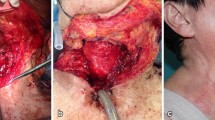Abstract
Purpose
Following long-term tracheostomy, reconstruction of the suprasternal notch and coverage of tracheocutaneous fistulas can be challenging. Often, aesthetic results are secondary to functional outcome. In this article, we propose a defect classification and a treatment algorithm using the tunneled supraclavicular artery island flap for functional and aesthetic reconstruction.
Methods
Twelve patients requiring complete or partial closure of a tracheocutaneous fistula or soft tissue deficit reconstruction were treated with this pedicled flap. Support for the anterior tracheal wall was achieved by including fascia or bone into the flap.
Results
Functional outcome was excellent, and suprasternal notch correction was achieved with good texture match. Donor sites could be closed primarily in every case. All flaps healed uneventfully, Long-term follow-up computed tomography scans demonstrated vital bone chips.
Conclusions
The proposed classification and treatment algorithm provides a structured approach to a successful surgical treatment of this complex condition.






Similar content being viewed by others
References
Arabi Y, Haddad S, Shirawi N, Al Shimemeri A (2004) Early tracheostomy in intensive care trauma patients improves resource utilization: a cohort study and literature review. Crit Care 8(5):R347–R352
Cacciaguerra S, Bianchi A (1998) Tracheal ring-graft reinforcement in lieu of tracheostomy for tracheomalacia. Pediatr Surg Int 13(8):556–559
Cordeiro PG, Mastorakos DP, Shaha AR (1996) The radial forearm fasciocutaneous free-tissue transfer for tracheostomy reconstruction. Plast Reconstr Surg 98(2):354–357
Delaney A, Bagshaw SM, Nalos M (2006) Percutaneous dilatational tracheostomy versus surgical tracheostomy in critically ill patients: a systematic review and meta-analysis. Crit Care 10(2):R55
Drezner DA, Cantrell H (1998) Surgical management of tracheocutaneous fistula. Ear Nose Throat J 77(7):534–537
Hallock GG (1992) The role of local fasciocutaneous flaps in total burn wound management. Plast Reconstr Surg 90(4):629–635
Jacobs JR (1995) Bipedicle delayed flap closure of persistent radiated tracheocutaneous fistulas. J Surg Oncol 59(3):196–198
Kashiwa K, Kobayashi S, Tono H, Nohara T, Honda T, Sakurai S (2009) Reconstruction of the cervical trachea using a prefabricated corticoperiosteal flap from the femur. Ann Plast Surg 62(6):633–636
Kierner AC, Zelenka I, Gstoettner W (2001) The sternocleidomastoid flap—its indications and limitations. Laryngoscope 111(12):2201–2204
Kulber H, Passy V (1972) Tracheostomy closure and scar revisions. Arch Otolaryngol 96(1):22–26
Marchese S, Corrado A, Scala R, Corrao S, Ambrosino N (2010) Tracheostomy in patients with long-term mechanical ventilation: a survey. Respir Med 104:749–753
Pallua N, Demir E (2008) Postburn head and neck reconstruction in children with the fasciocutaneous supraclavicular artery island flap. Ann Plast Surg 60(3):276–282
Pallua N, Machens HG, Rennekampff O, Becker M, Berger A (1997) The fasciocutaneous supraclavicular artery island flap for releasing postburn mentosternal contractures. Plast Reconstr Surg 99(7):1878–1884, discussion 1885-6
Pallua N, Magnus NE (2000) The tunneled supraclavicular island flap: an optimized technique for head and neck reconstruction. Plast Reconstr Surg 105(3):842–851, discussion 852-4
Pallua N, von Heimburg D (2005) Pre-expanded ultra-thin supraclavicular flaps for (full-) face reconstruction with reduced donor-site morbidity and without the need for microsurgery. Plast Reconstr Surg 115(7):1837–1844, discussion 1845-7
Priestley JD, Berkowitz RG (2006) Closure of tracheocutaneous fistula in children. Int J Pediatr Otorhinolaryngol 70(8):1357–1359
Riedel F, Reinhart Goessler U, Grupp S, Bran G, Hormann K, Verse T (2006) Management of radiation-induced tracheocutaneous tissue defects by transplantation of an ear cartilage graft and deltopectoral flap. Auris Nasus Larynx 33(1):79–84
Author information
Authors and Affiliations
Corresponding author
Additional information
Author’s contributions
Both authors were equally involved in study design, data acquisition, and analysis as well as drafting and revision of the manuscript.
Rights and permissions
About this article
Cite this article
Pallua, N., Wolter, T.P. Defect classification and reconstruction algorithm for patients with tracheostomy using the tunneled supraclavicular artery island flap. Langenbecks Arch Surg 395, 1115–1119 (2010). https://doi.org/10.1007/s00423-010-0654-x
Received:
Accepted:
Published:
Issue Date:
DOI: https://doi.org/10.1007/s00423-010-0654-x




